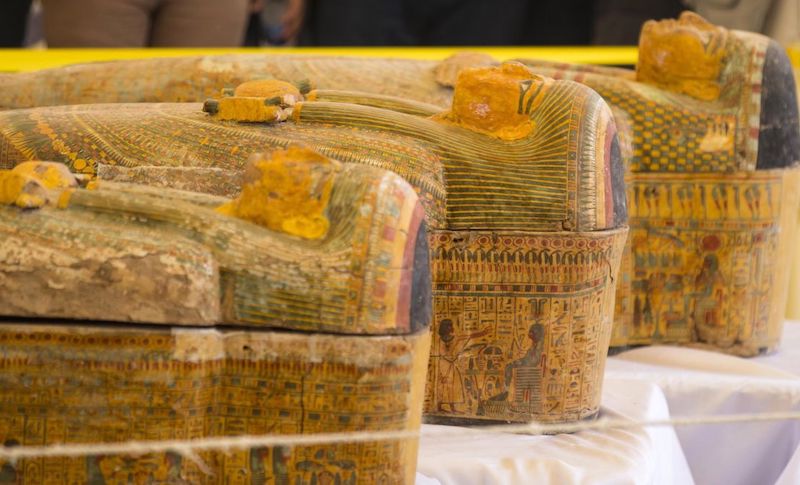Egypt’s Top 10 Archaeological Discoveries of 2019
It's been an amazing year for archaeology.

Looking back, 2019 was a fantastic year for archaeological missions in Egypt. A plethora of new discoveries and preservations were uncovered, giving us the feeling that the magic of Egyptian history is practically endless. Let’s take a look at some of the most significant discoveries of the year:
1. Ancient Roman townhouse and university in Alexandria

An Egyptian-Polish archaeological mission uncovered remains of an Ancient Roman town in Alexandria’s Kom El-Dekka in July. The discovery included a collection of mosaics covering the floor of a townhouse, a small theatre, a massive imperial bathroom and a unique collection of 22 lecture halls, which are believed to be the remains of an old university.
2. 30 coffins holding Ancient Egyptian priest mummies

Archaeologists unearthed 30 sealed wooden coffins with priest mummies within at El-Assasifan ancient necropolis nearby Luxor in October. The coffins date back to about 3,000 years but were astonishingly well-preserved, and included 23 adult males, 5 adult females and 2 children.
3. Sohag tomb and Tutu’s mummy

Archaeologists uncovered a unique and intact tomb in Egypt, whose inscriptions still have their original colour. Believed to be the tomb of a high-ranking official from the Ptolemaic Period called Tutu, the tomb contained tens of mummified animals, in addition to one human mummy, which is believed to have once been the owner of the tomb.
4. Ramses II statue under Giza house

A bust of Ramses II was discovered in Mit Rahina village near the Great Pyramids of Giza. The bust is considered an extremely rare find as it is made from rose granite. It was found alongside remains of an ancient temple to Ptah, a patron god. Initially, a 62-year old resident of the village attempted to excavate it illegally underneath his home until a team from the Ministry of Antiquities was sent to continue the dig.

An Egyptian archaeological mission discovered the tomb of a Fifth Dynasty official named Khuwy in Saqqara back in April. The tomb was incredibly well preserved, carrying all its original colours. The sarcophagus and mummy of Khuwy were found in ruins as a result of an attempted robbery, but the remains show clear signs of mummification.
6. Discoveries in Underwater Cities of Heracleion and Canopus

Discoveries including jewellery, new ports, pottery, and temple ruins were made in July about 32km northeast of Alexandria in the ancient underwater cities of Heracleion and Canopus. The mission was able to conclude that the city was much bigger than previously thought.
7. The accidental discovery of 20 Greco-Roman and Ptolemaic Sites

Some 20 archaeological sites from the Ptolemaic and Greco-Roman eras were uncovered in central and east Alexandria by coincidence after the land was identified for construction suitability.
8. Strange Egyptian head cones

What was once considered an artistic depiction was discovered earlier this month in Akhetaten. The mysterious cone-shaped headwear, made of bees-wax, was found in a grave by a team of archaeologists from Monash University in Melbourne and the Ministry of Antiquities.

Various animal and bird mummies, as well as 75 wooden and bronze statues, were discovered at the Bubastian necropolis in Saqqara in November. Two of the animal mummies were lion cubs, which is an extremely rare find. The discovery also included a very rare stone scarab, which Mostafa Waziri, secretary-general of the Supreme Council of Antiquities, dubbed “the largest in the world.”
10. Limestone coffin housing 2 mummies

An Egyptian archaeological mission from the Ministry of Antiquities unearthed a well-preserved coffin made out of limestone that was carrying two poorly preserved mummies in the Qesna quarry excavation site in Monufia back in April.
- Previous Article CairoScene NYE Guide 2020
- Next Article Etisalat and Tech Fuze Inspire the Next Generation of Tech Leaders
Trending This Week
-
Mar 09, 2025























